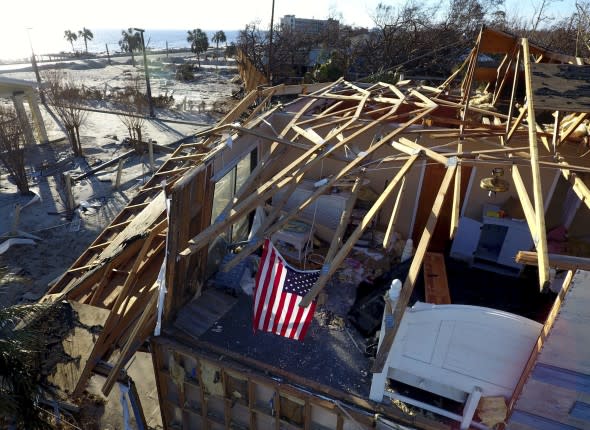How Carolinas, Florida are handling the upcoming midterm elections following 2 devastating hurricanes
With the pivotal midterm elections several weeks away, hurricanes Michael and Florence have been major obstacles to the administrative procedures for the election in the hardest-hit locations in the Carolinas and Florida.
Homes and businesses have been lost due to historic flooding and catastrophic winds and many families are still grappling with the reality following the destruction as they move into temporary housing or begin the process of applying for federal aid. Tens of thousands remain without power in some portions of the Florida Panhandle following Michael and some roads are still being repaired.
Several tightly contested races are underway in Florida, including the gubernatorial race between Tallahassee Mayor Andrew Gallium, a Democrat, and Republican Ron DeSantis, the former U.S. Representative from the state's sixth district. A second pivotal race is taking place for a seat in the U.S. Senate between incumbent Democratic Sen. Bill Nelson, and outgoing Republican Gov. Rick Scott.
Even prior to Michael's landfall, Florida officials assessed potential impacts to voting sites and were taking steps to come up with alternative measures in case voting sites couldn't be used during the election.
"The Florida Department of State's top priority is ensuring that there are ample opportunities for Floridians impacted by Hurricane Michael, many of whom lost their homes, to be able to cast ballots while protecting the integrity of the 2018 General Election," officials said in a statement.

An American flag hangs in a bedroom of a damaged home from Hurricane Michael in Mexico Beach, Fla., Tuesday, Oct. 16, 2018. (AP Photo/David Goldman)
Scott recently issued an executive order allowing supervisors of elections in the eight counties hit hardest by Michael to extend and enhance voting options based on needs and challenges they have identified.
The supervisors are now able to extend the amount of days of early voting, designate additional early voting locations and expedite the delivery and acceptance of vote-by-mail ballots. The order also ensures that National Guard troops, first responders, utility workers, law enforcement and other volunteers conducting relief efforts are able to cast a ballot.
Damage to polling locations in Florida have been reported, but supervisors have not described any damage to voting machines or other election-related equipment such as ballots.
Secretary of State Ken Detzner also extended the voter registration deadline in counties where offices were closed due to Michael's approach.
"The department shares the governor's commitment to ensuring that all registered voters from counties devastated by Hurricane Michael are able to exercise their right to vote safely and securely in the upcoming general election," he said in a statement.
In North Carolina, Gov. Roy Cooper extended the voter registration deadline in 28 counties the most affected by Florence.
"We do not want this devastating storm to keep people from voting," said Kim Westbrook Strach, the North Carolina State Board executive director. "Voters may cast ballots by mail or in person during the early voting period or on Election Day. We hope voters take advantage of the option that works best for them at this difficult time."
Early voting began on Oct. 17 in North Carolina and runs through Nov. 3. In the affected Florida counties, early voting began Monday, Oct. 22 and can extend through Election Day.
North Carolina residents who were displaced by the storm can request an absentee ballot to be sent to their current location, even if it's not their permanent residence. In addition, absentee by-mail ballots that are delivered to the proper county board of elections office in any of the 28 counties should be counted if received by 5 p.m., Nov. 15.
Voter registration was also extended in South Carolina as many roads or registration offices were closed following Florence's flooding.
In 2012, Superstorm Sandy leveled parts of the northeastern United States, with New Jersey and parts of New York City suffering some of the worst impacts. The storm occurred about one week prior to the presidential election between Barack Obama and Mitt Romney.
David Redlawsk, the chair of the political science department at the University of Delaware, said New Jersey had its lowest turnout for a presidential election that year.
"Hundreds of polling places were closed or damaged, and in some parts of the state electricity was not yet restored by Election Day," he told AccuWeather.
Unlike Sandy, Florence and Michael struck several weeks to over a month ahead of the general election, giving authorities time to clear debris and make proper changes to polling locations. Whether or not the two hurricanes lead to a lower turnout at the polls won't likely be determined until after the election, if at all, according to Redlawsk.
"In midterm elections, turnout is always much lower than in a presidential election, so even low turnout may not be because of the weather," he said.
